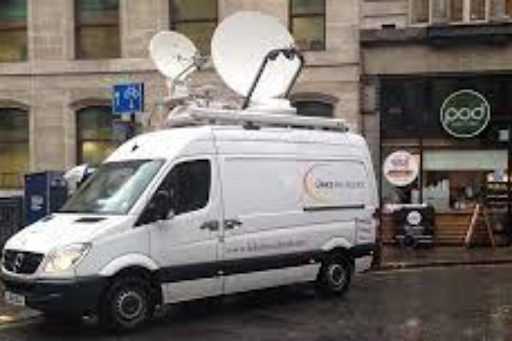
Introduction
what is outside broadcasting refers to live or recorded radio and television production carried out away from a traditional studio setting. While the name might suggest outdoor activity, OB can take place anywhere — inside arenas, public venues, or even remote locations — as long as it’s beyond the four walls of a broadcast studio.
This form of broadcasting has evolved dramatically since the early 20th century. Over the decades, it has embraced cutting-edge innovations, setting the pace for live video production worldwide. From the first grainy broadcasts to today’s ultra-HD multi-camera coverage, OB remains at the heart of real-time storytelling.
OB Vehicles: A Modern Marvel
Today’s OB units range from compact sprinter vans to massive, technologically advanced trucks like Ross Production Services’ RPS9, recognized as one of the most powerful mobile broadcast units in the U.S. These vehicles function as high-tech control rooms on wheels — handling every element of a live production, from camera feeds to final signal output.
The integration of fiber optics, cellular bonding, and 5G technology has significantly enhanced the flexibility and quality of OB. These tools enable crews to stream high-resolution video from virtually anywhere, making remote production smoother and more efficient than ever before.
Real-World Applications
Sports Coverage
Live sports demand precision. Whether it’s capturing the electric atmosphere of the Olympics or the multi-layered spectacle of the Super Bowl, OB units are critical for covering every pivotal play and fan reaction. These mobile setups are tailored to deliver high-quality content in real time to millions of viewers across the globe.
Breaking News
When it comes to news reporting, OB setups are indispensable. From presidential inaugurations to emergency disaster coverage, mobile crews ensure that every key moment is broadcast instantly. Real-time visuals and on-the-ground reporting help audiences stay informed during unfolding events.
Music Events
Want to enjoy the buzz of Coachella or Glastonbury without leaving your home? OB makes it possible. These broadcasts allow people worldwide to feel the pulse of live performances, offering a front-row experience through the screen.
Ceremonial Occasions
OB is also pivotal for covering high-profile events like royal weddings, state funerals, and New Year’s Eve in Times Square. These productions bring iconic moments to the masses, uniting global audiences through shared live experiences.
The Mechanics Behind OB
Production Setup
Each OB production is a coordinated effort involving multiple specialized professionals. The team usually works from a mobile control unit equipped with:
- Switchers (like Carbonite) and control panels for selecting and managing video feeds.
- Routing systems (such as Ultrix) to direct signal flow.
- Replay servers (like Mira) for instant highlights.
- Audio mixers for crystal-clear sound balance.
- Multiviewers for real-time monitoring of all sources.
- A fleet of HD and UHD cameras, both stationary and mobile.
Inside the truck, the director, technical director, audio engineers, vision mixers, and graphics operators collaborate in real time. From adjusting camera angles to overlaying graphics, each person plays a vital role in delivering a seamless broadcast.
Camera Work
what is outside broadcasting the truck, camera operators capture footage based on a carefully choreographed plan. Whether it’s tracking a touchdown, zooming in on a concert solo, or panning across a political rally, camera movement and placement are key. Precision and timing are everything.
Transmission Technology
Once the production feed is finalized, it’s transmitted to viewers using several methods:
- Satellite Links – Reliable and widely used for long-range transmission.
- Fiber Optic Cables – Provide high bandwidth and minimal delay, ideal for large-scale events.
- Cellular Networks – Powered by 4G and 5G, these support mobile transmission, especially in areas without fiber or satellite access.
Signal routing inside the OB vehicle ensures that each feed is directed to the appropriate destination. Once everything is compiled and mixed, the final output is encoded and sent to broadcasters or streaming platforms, eventually reaching your TV or mobile device.
OB vs Studio Production
Key Differences
While studio-based production offers controlled environments and predictable outcomes, it lacks the on-location energy and immediacy of OB. OB delivers immersive experiences but involves higher logistics, travel, and equipment demands.
The Hybrid Model
To balance these challenges, many broadcasters now use the REMI model (Remote Integration Model). This system allows certain production components (like switching or audio mixing) to happen off-site, often at a central studio, while cameras and minimal staff remain on location. This setup offers efficiency and reduced costs but requires reliable, low-latency connectivity.
The Human Element
Behind every successful OB broadcast lies seamless teamwork. Producers bring narrative vision and coordination, while technical crews manage logistics and execution. Together, they synchronize creativity and precision, ensuring smooth coverage regardless of the setting.
The Ross Video Edge
Ross Video is a major force in the OB industry, developing much of the advanced gear used by mobile production units around the world. Their innovations include:
- Ultrix: A hyperconverged platform that simplifies signal routing and control.
- XPression: A powerful real-time graphics system used for live overlays and animation.
- Mira Replay: A popular tool for sports broadcasting, enabling instant replay with smooth operation.
- Ross Production Services (RPS): A leading production arm that operates top-tier OB trucks like RPS9 and FIN3, designed for events of any scale.
Ross’s solutions aim to make OB more efficient, sustainable, and scalable, supporting a wide range of productions — from small events to global broadcasts.
Final Thoughts
what is outside broadcasting broadcasting remains a backbone of modern live production. Whether it’s a thrilling sports finale, a breaking news event, or a globally celebrated concert, OB delivers real-time storytelling to audiences everywhere.
As technologies advance, the future of OB lies in hybrid models, 5G capabilities, and smarter production systems. Companies like Ross Video continue to push boundaries, making it easier, faster, and more impactful to connect the world through live events.
Get the latest innovations and trends—follow magazine !